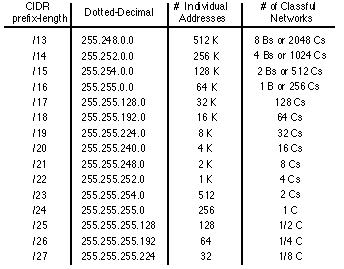




Classless Inter-Domain Routing (CIDR)
By 1992, the exponential growth of the Internet was beginning to raise serious concerns among members of the IETF about the ability of the Internet's routing system to scale and support future growth. These problems were related to:
CIDR was officially documented in September 1993 in RFC 1517, 1518, 1519, and 1520. CIDR supports two important features that benefit the global Internet routing system:
CIDR Promotes the Efficient Allocation of the IPv4 Address Space
CIDR eliminates the traditional concept of Class A, Class B, and Class C network
addresses and replaces them with the generalized concept of a "network-prefix."
Routers use the network-prefix, rather than the first 3 bits of the IP address,
to determine the dividing point between the network number and the host number.
As a result, CIDR supports the deployment of arbitrarily sized networks rather than
the standard 8-bit, 16- bit, or 24-bit network numbers associated with classful
addressing.
In the CIDR model, each piece of routing information is advertised with a bit mask (or prefix-length). The prefix-length is a way of specifying the number of leftmost contiguous bits in the network-portion of each routing table entry. For example, a network with 20 bits of network-number and 12-bits of host-number would be advertised with a 20-bit prefix length (a /20). The clever thing is that the IP address advertised with the /20 prefix could be a former Class A, Class B, or Class C. Routers that support CIDR do not make assumptions based on the first 3-bits of the address, they rely on the prefix-length information provided with the route.
In a classless environment, prefixes are viewed as bitwise contiguous blocks of the IP address space. For example, all prefixes with a /20 prefix represent the same amount of address space (2 12 or 4,096 host addresses). Furthermore, a /20 prefix can be assigned to a traditional Class A, Class B, or Class C network number. Figure 27 shows how each of the following /20 blocks represent 4,096 host addresses - 10.23.64.0/20, 130.5.0.0/20, and 200.7.128.0/20.

Figure 27: /20 Bitwise Contiguous Address Blocks
Table 3 provides information about the most commonly deployed CIDR address blocks. Referring to the Table, you can see that a /15 allocation can also be specified using the traditional dotted-decimal mask notation of 255.254.0.0. Also, a /15 allocation contains a bitwise contiguous block of 128K (131,072) IP addresses which can be classfully interpreted as 2 Class B networks or 512 Class C networks.

Table 3: CIDR Address Blocks
Unterkapitel:
Host Implications for CIDR Deployment
Efficient Address Allocation
CIDR Address Allocation Example
CIDR is Similar to VLSM
nächstes Hauptkapitel:
Routing in a Classless Environment